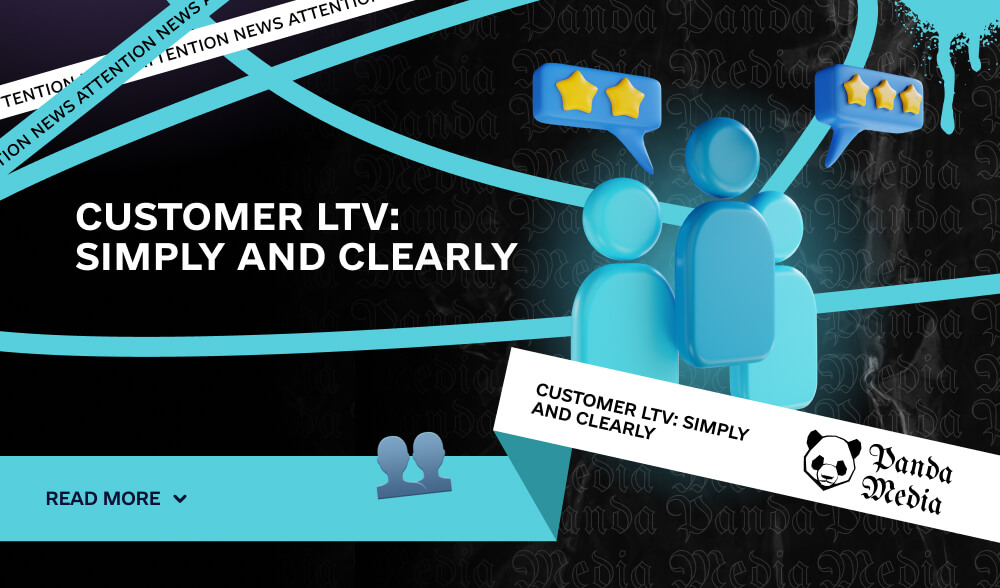Calculating customer LTV is important because it is cheaper to retain existing customers than to attract new ones. It is more difficult to sell to new customers: the probability of purchase is only 5-20%, while existing customers buy with a probability of 60-70%. Therefore, you need to build a strategy so that customers do not leave after the first purchase, but keep coming back.

LTV, also known as CLV or CLTV (customer lifetime value), shows how much money a company can earn from a customer over the entire period of their interaction with the brand. It helps you understand how much you can spend on advertising and retention, as well as evaluate the effectiveness of your marketing efforts. With LTV, we can divide customers into groups to find out who is most valuable and create loyalty programs tailored to their needs.
In addition, LTV helps us find out which customers bring in the most revenue. This knowledge allows you to customize ads and improve targeting. The main reasons why you need to calculate LTV:
- Helps improve customer retention.
- Shows how much you can spend on retention and acquisition.
- Makes offers more relevant to different customer groups.
- Improves advertising and communication strategies.
- Allows you to forecast revenue for the nearest period.
- Determines which channels of attraction work best.
Now let’s analyze what influences LTV and how to calculate it.
How to calculate LTV?

LTV of a customer shows how much profit he brings to the company during the entire period of cooperation. It depends on the average check size, frequency of purchases, and duration of interaction with the customer. You can calculate LTV both for one customer and for a group. Understanding the LTV formula helps to make sure that the cost of attracting customers does not exceed the income received from interacting with them.
The simple LTV formula:
LTV = profit from a customer – costs of attracting and retaining them.
A more accurate formula:
LTV = average order value × average number of purchases per month × term of cooperation in months.
To calculate the total lifetime value excluding costs, use:
LTV = LT × AOV × RPR × AGM,
where:
- LT (Lifetime) – the term of interaction with the client.
- AOV (Average Order Value) – average check.
- RPR (Repeat Purchase Rate) – frequency of purchases per month.
- AGM (Average Gross Margin) – the average margin showing the share of net profit.
Margin (AGM) is calculated as follows:
AGM = (TR – CS) / TR,
where:
- TR (Total Revenue) – total revenue.
- CS – cost of service.
To calculate the LTV of a certain segment:
LTV = ARPU × LT,
where:
- ARPU (Average Revenue Per User) – the average profit per customer for a certain period.
- LT – the average term of cooperation.
ARPU can be found by the formula:
ARPU = TR / CQ,
where:
- TR – profit from the segment for the selected period.
- CQ – the number of customers in the segment for the same period.
It is also important to understand the “quality of the client” to assess how profitable the client is for the company:
Customer quality = LTV / CAC,
where CAC (Customer Acquisition Cost) is the cost of attracting a customer, calculated as:
CAC = marketing expenses for the period / number of attracted customers.
The ratio of LTV and CAC shows the effectiveness of the company:
- 1:1 – you need to change the approach, the profit only covers the costs.
- 2:1 – low payback.
- 3:1 and above – a good result.
Metrics related to the client’s LTV

Customer TV is linked to several other important metrics that help measure business performance. These include:
- CAC (Cost of Customer Acquisition) – the cost of customer acquisition. This indicator shows how much a company spends to attract one customer.
- ROI (Return on Investment) – return on investment. This indicator helps to assess how effectively the invested funds are used.
- Churn – the rate of customer churn. A high churn rate can negatively affect LTV as customers leave earlier than expected.
- ACV (Annual Contract Value) – the annual contract value. This indicator is important for companies operating on a subscription model.
- ARPU (Average Revenue Per User) – the average revenue per customer. This indicator helps to understand how much one customer brings in on average over a certain period.
- AOV (Average Order Value) – the average order size. This indicator shows how much a customer spends on average per purchase.
These metrics help to evaluate business performance and determine what strategies should be applied to increase customer LTV. For example, if the CAC is too high, it may indicate the need to optimize marketing costs. By analyzing ARPU and AOV, you can identify opportunities to increase the average check and revenue per customer.
FAQ
How to increase the lifetime value of a customer?
Low LTV is often associated with insufficient quality of goods, poor service, or poor communication. To increase customer lifetime value and loyalty, use different methods. Here are the main recommendations.
Why is it important to collect feedback?
Feedback helps to understand what customers like or dislike and identify weaknesses in service. It is an important tool for improving the quality of service and building brand trust.
Why do you need a loyalty program?
A loyalty program motivates customers to return and make repeat purchases. You can offer bonuses, discounts, or gifts for purchases. The main thing is to make the program understandable and beneficial for customers.
How to respond to customers quickly?
Customers expect instant responses, which directly affects their satisfaction and frequency of sales, so it’s important to be in touch 24/7. Use chatbots, online chats, and other tools to provide quick feedback and support.
What are omnichannel strategies and why do you need them?
Omnichannel strategies include interacting with customers through email, SMS, chatbots, and push notifications. This helps to increase the number of touchpoints and motivate customers to make repeat purchases.
Why are upselling and cross-selling important?
Offering additional products or services helps to increase the average check and strengthen customer relationships, which increases their lifetime value (ltv ltv).
How to personalize offers?
Segment your audience and collect customer data to create personalized campaigns and offers to increase customer relevance and loyalty.
How to attract customers through social media?
Run promotions, contests, and guides, work with opinion leaders. This increases the engagement and trust of the target audience in your brand.
Why use referral programs?
Referral programs encourage customers to refer new customers, which increases your audience and builds loyalty among current customers.
Why is it important to track LTV along with other metrics?
Tracking LTV, ROI, and CAC helps to evaluate the effectiveness of marketing strategies, optimize customer acquisition costs, and choose the most efficient promotion channels.
Conclusion
Customer LTV is a crucial indicator for businesses as it helps to determine how many resources can be invested in customer acquisition and retention to maximize profits. To calculate customer LTV, you need to take into account several metrics, including CAC, ROI, Churn, ACV, ARPU, and AOV. By analyzing these metrics, businesses can determine which strategies to implement to increase customer LTV and maximize profits.
Understanding and utilizing LTV allows companies not only to allocate resources efficiently, but also to build long-term relationships with customers, which ultimately leads to sustainable growth and business success.


